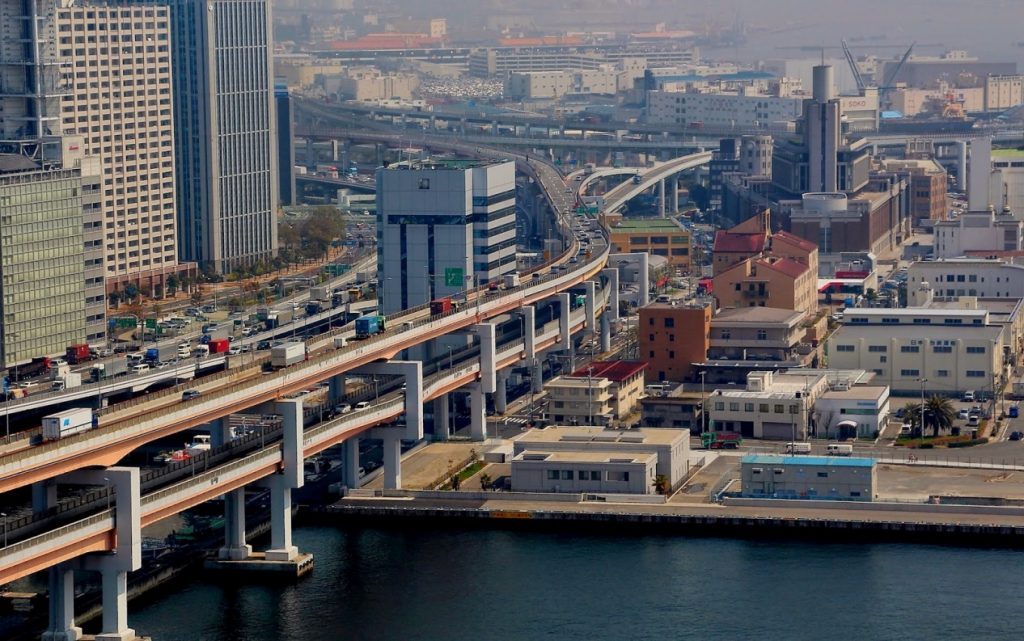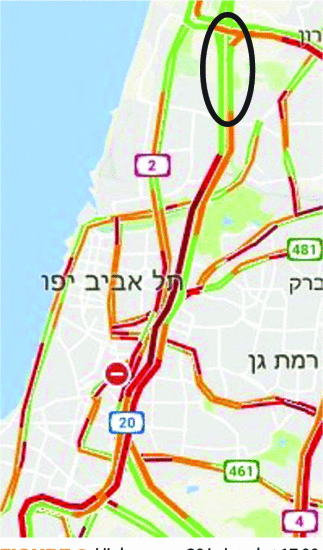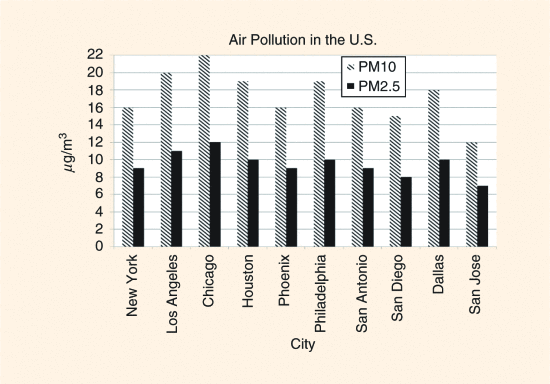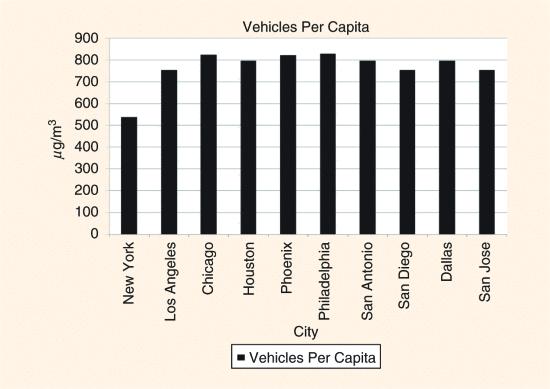 Figure 1. Second level of roads in Kobe, Japan.
Figure 1. Second level of roads in Kobe, Japan. Driverless vehicles will be common on the road in a short time. They will have many impacts on global transport market trends. One remarkable impact of driverless vehicles will be the laying aside of rail systems, for several reasons. The main reasons are that traffic congestion will no longer be a justification for rail, rail will not be the best answer for the disabled, and air pollution caused by driverless cars is more or less equal to air pollution from trains. Last but not least is that driverless cars are safer than trains.
Why Rail is Alive and Subsidized
There are four key reasons why rail is still alive and even subsidized in most countries:
- To reduce congestion on jammed roads [1].
- As a transportation means for people who are unable to drive because of disability or an exhausting job [2].
- To reduce air pollution, because one train can replace many cars [3].
- To reduce the number of vehicle accidents and fatalities [4].
To a certain extent, some of these arguments are only valid until driverless cars are available on the market. In four states in the U.S. – Arizona, California, Michigan, and Ohio, driverless vehicles are available without the necessity of a driver. This article shows that reasons 1)-4) detailed above are no longer valid reasoning for rails, nor are they valid justification.
Traffic jams and are mainly triggered by varied responses to events on the roads, and by the different driving patterns of different drivers.
Traffic Congestion is not a Justification for Rail
Studies in various countries have shown that today’s traffic jams and congestion are mainly triggered by varied responses to events on the roads, and by the different driving patterns of different drivers [5]-[6]. On the other hand, driverless cars of even competing companies will behave much the same way, so that traffic congestion will be significantly alleviated when driverless cars are the standard.
In addition, street parking occupies areas that could be utilized for moving vehicles [7]. A vacant driverless vehicle can move automatically to a remote parking. Freeing up street parking space will generate uncomplicated road expansion.
Another issue is the subsidization of rail systems. Most countries subsidize their rail systems. China invests $128 billion in rail each year [8], whereas Europe invests €73 billion in rail each year [9]. The subsidies are a primary piece of rail system budgets almost anywhere in the world. Only Japan’s rail system is not subsidized. Without subsidies, almost no rail system can survive. Only some lines of freight rails can be moneymaking [10]. However, freight rails will also have more competition with new technologies of self-driving truck platoons [11]. Accordingly, most rail systems will perish as soon as rail subsidies are ended.
In reality, rail systems lose billions of dollars every year. If existing rail systems cannot stay alive, they should be allowed to humbly depart this life. The billions saved from funding rail systems can be invested in roads with the aim of reduction of traffic congestion.
Where road expansion is possible, it should be carried out. Where a road expansion is impossible, a second level of roadway should be built as has been done in Kobe, Japan, Chicago in the U.S. and many other places in the world. A second level of roads in Kobe, Japan, is shown in Figure 1. A second floor of traffic lanes on the highway was built in Iran across Tehran as well. Any road can be expanded, and money saved from eliminated rail system subsidies can be used for this expansion.
Another example is the most congested highway in Israel — Highway no. 20. In October 2013 a section of this highway was expanded to five lanes northbound and southbound [12]. As a result, this section became uncongested. Figure 2 shows the traffic congestion at 17:00 in Highway no. 20 in Israel. The expanded section is surrounded by an ellipse. It can be easily seen that in this section the congestion has been released.
Rail is not the Best Answer for the Disabled
In the era of driverless cars, even people with disabilities or people with an exhausting job will be able to travel in a car without driving. What is more, a shared driverless car will be much more attractive than a train arriving at a location not nearby home. New apparatus like that shown in [13], for mounting wheelchair securement devices to existing vehicle seat mounting structures, can be attached to vehicles with the aim of making them more user friendly for them disabled.
Furthermore, drunk, reckless, or distracted drivers usually are not mindful of their unsafe way of driving. Many authorities try to convince these drivers to leave their cars and make use of public transportation such as trains. Some of these drivers come to an understanding that it is better for them not to drive, but there are still too many vehicles in the hands of inept drivers. When driverless cars become standard, these risky drivers will not exist.
Street parking occupies areas that could be utilized for moving vehicles.
When the use of driverless cars becomes widespread, the question of whether the state must provide rail services, or instead rail services should be profitable privately-owned businesses such as in the Japanese model, will be an interesting question for historians of transportation.
Air Pollution Caused by Rail and Cars is More or Less Equal
Modern vehicles, if kept in satisfactory condition, will emit very small amounts of air pollutants. New cars are manufactured with advanced catalytic converters [14] and in most of developed countries use of catalytic converters is obligatory [15]. In addition, the selling of leaded fuel is outlawed in most developed countries. Unleaded fuel is obligatory because lead is a potent neurotoxin and pollutant. But in most developed countries, unleaded fuels are standard [16].
On the other hand, many developing countries do not inspect the emission of vehicles moving in their territory. Nor do they inspect the quality of the fuel sold in gas stations. Also, since catalytic converters contain expensive materials like platinum, palladium, rhodium, and gold, thefts of catalytic converters are not unusual. In developing countries, sometimes even the car owner takes out the catalytic converter and sells it [17]. The car owner will be paid for the catalytic converter, but everyone else will breathe in the pollutants.
It is common to measure the pollution concentration in the air by the values of PM10 and PM2.5; whereas PM10 is particulate matter in diameter of no more than 10 micrometers and PM2.5 is particulate matter in diameter of no more than 2.5 micrometers [18]. Therefore, PM2.5 will never be greater than PM10.
The typical threshold for air pollution is quite similar in most developed countries. The American standard [19] is in accordance with the World Health Organization’s stipulating of a threshold of 50 for PM10 [20]. The Europeans are more cautious with a threshold of 40 for PM10 [21]. The threshold of 25 is accepted worldwide as the threshold of PM2.5.
In the United States, despite the relatively high rate of motorization, the average concentration of air pollution in the 10 most populous U.S. cities is well below the threshold. The concentrations of pollutants published by the World Health Organization [22] for these cities are detailed in Figure 3. The number of vehicles per capita published by the U.S. Federal Highway Administration [23] is detailed in Figure 4. The total number of vehicles per capita in the U.S. is 797, which is a much higher number than the typical number of vehicles per capita in the world. Still the air in United States cities is relatively less polluted.
On the other hand, in many developing countries, vehicles have not been checked properly by environmental regulating authorities. This leads to increased concentrations of pollution. We can take for example Nigeria which has much higher concentrations of both PM2.5 and PM10. Nigeria’s pollution statistics are shown in Figure 5. At the same time it is flabbergasting to realize that there are only 61 vehicles per capita in Nigeria [24], which is just 7.65% of the rate of motorization in the U.S.
Large numbers of modern private cars create only a very slight amount of pollutants. The pollution is mainly generated by defective vehicles, leaded fuel, and fuel mixed with oils that are unacceptable in developed countries. Therefore, the explanation for the enormous excess in the concentration of pollutants in the air of Nigeria is not just traffic emissions, but rather the nature of those traffic emissions.
In reality, rail systems lose billions of dollars every year.
In addition, there are more reasons for Nigeria’s bad air quality. For examples, improper waste treatment such as burning of waste, and unfiltered emissions from industrial plants near living areas, as can be seen in Figure 6.
Air pollution generated by means of transportation has been significantly reduced in recent years, and is no longer an acute concern. According to [25], by 2040, CO2emissions will no longer be an issue for means of transportation any longer in Europe. Therefore it is unreasonable to spend billions of dollars to subsidize trains, which will yield almost no improvement in air quality.
Modern private cars create only a very slight amount of pollutants.
Driverless Cars are not Less Safe than Rails
Nowadays, it is customary to accept as true that among all transportation means, train travel is the safest. In 2015, there were only 749 recorded deaths in the U.S. in rail related accidents; whereas in the same period 35 092 people died in the U.S. in highway crashes [26]. Road crashes are the leading cause of death among young people ages 15–29 and account for 2.2% of all deaths globally.
In addition, road crashes impose significant costs. Simulations of traffic accidents indicate that more damages are generated to cars in accidents, because they are feebler than train bodies. The annual cost of road accidents is US$518 billion globally, costing individual countries from 1%-2% of their annual GDP [27].
In [28] it is claimed that in cities where rail transit is a major component of the transportation system, 36% lower per capita vehicle accident fatalities are expected (7.5 versus 11.7 annual deaths per 100 000 residents) even though a single rail accident on its own statistically claims more lives than a single car accident.
Accordingly, various authorities in more than a few countries believe that many lives can be saved by shifting some traffic to trains.
However, this entire line of reasoning will be irrelevant when driverless cars are available. By automating driving, 95% of car crashes could be eliminated [29], because many safety gadgets will be installed in the driverless cars. Most trips in the U.S. are currently undertaken by cars, whereas trains carry only a small percentage of passengers. According to the U.S. Department of Transportation, 3 130 509 million miles were traveled on the U.S. highway system in 2015, and in the same period only 532 million miles were traveled by trains [30]. So even now, it is not clear that rail travel is safer. When driverless cars are available, it will be as clear as daylight that driverless cars are much safer than conventional trains.
However, the rail system will be also driverless, so train safety also will be improved, and both driverless cars and driverless trains will have an almost zero probability of having a fatal accident. For that reason it will unreasonable to subsidize trains with the aim of convincing people to travel in this means of transportation that essentially will have almost the same safety attributes and qualities as driverless car travel.
Rail Service Will Fade Away
Trains are a means of transportation that were invented more than 200 years ago. In this article we have shown that in the age of driverless cars, a means of transportation that takes many people from one central station to another central station has lost justification for its existence. The reasons detailed here that are commonly accepted as true are no longer valid.
Driverless cars are much more restful and comfortable for passengers than rail services. Moreover, train stations are not often in a close proximity to passengers, so passengers must use other means of transportation to travel to the train station. Use of driverless cars will not involve any need for the hassle of these connections. As a result, driverless cars will gradually dominate the transportation market [31]. As more and more driverless cars are on the roads, the trains will slowly but surely fade away from our lives.
Author Information

Yair Wiseman is with Bar-Ilan University, Israel. Email: wiseman@cs.biu.ac.il.
To read this full article, including references, click HERE.











 JOIN SSIT
JOIN SSIT